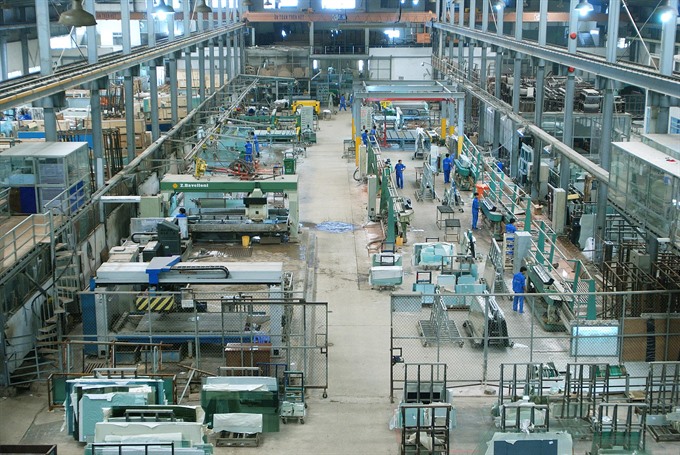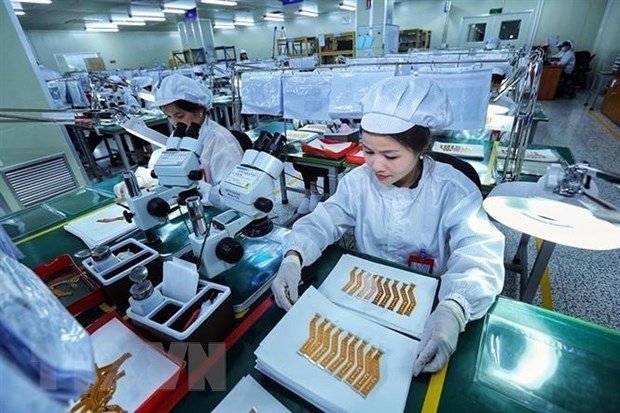 Economy
Economy

Total economic growth rate for the first quarter of 2017 is 5.1 per cent, the lowest out of the last three years, with the Vietnam Economic Performance Index (VEPI) clocked in at 5.8 per cent, according to the Vietnam Centre for Economic and Policy Research (VEPR)’s quarterly report and independent assessment of Việt Nam’s macroeconomic policies.
 |
| A view of the Phú Phong Product Service and Stock Company’s factory in HCM City. — Photo phuphong.com |
HÀ NỘI — With first quarter growth in 2017 the lowest in the last three years at 5.1 per cent, the targeted GDP growth of 6.7 per cent this year will be a tough task, a new report says.
The quarterly report, prepared by the Vietnam Centre for Economic and Policy Research (VEPR), purports to be an independent assessment of the nation’s macroeconomic policies.
It says that the sluggish performance has brought down the Vietnam Economic Performance Index (VEPI) down to 5.8 per cent.
The first quarter VEPI indicates an economic decline, with industrial production index up just 4.1 per cent, the report says.
Only the inventory index managed to stay high in January and February 2017, it notes.
It predicts that with such a low growth rate in the first quarter, the annual growth target of 6.7 per cent might prove unattainable.
Inflation is slowing down and stabilising, with a year-on-year rise of just 4.65 per cent, due to declining prices of basic commodities.
However, the difference between core inflation and headline inflation indicates great difficulty in keeping the rate down to under 4 per cent when consumption demand bounces back alongside public spending.
“The State Bank has exercised strict control to prevent inflation with highly efficient monetary policies. Interest rates fluctuations from the Fed’s prime rate hike in the last month and US dollar gains at the end of 2016 have been curbed in recent times. Credit is gaining fast, indicating businesses’ needs for growth,” said VEPR President Nguyễn Đức Thành.
Thành also felt that with a carefully monitored monetary policy, inflation can be kept to under 5 per cent.
“The first quarter growth tends to be the lowest one out of the year, and I expect the upcoming months to pick up quickly. The recorded low inflation rate may not continue for long, however, the current development model will create high total demand and hike inflation. Unless the US’ Fed announces another interest hike, the exchange rate will not create pressure on domestic inflation,” said Trương Đình Tuyển, former Trade Minister.
The manufacturing and processing sector experienced an “abnormally low growth level” of 8.3 per cent, compared to the same period last year. The agriculture, forestry, and aquaculture sector saw a 2 per cent growth rate, while the service sector grew by 6.5 per cent.
Overall, industrial growth was just 3.85 per cent in the first quarter of 2017, the lowest since 2011.
Consumption also saw an overall year-on-year decline to 4.4 per cent in January before bouncing back to 7.9 per cent in February, giving the retail sector a year-on-year growth of 9.2 per cent and the service sector 6.52 per cent.
Exports posted a rapid growth in terms of value at 12.8 per cent, while imports grew 22.7 per cent year-on-year, resulting in a Q1 trade deficit of US$2 billion.
With such little progress in the industrial sectors, GDP is disproportionately dependent on the foreign direct investment sector. This creates a high level of trade growth without corresponding gains in export value, experts said.
“Investment flow to Việt Nam is also being constricted by many countries as the US is also pursuing new trade and monetary policies, so Việt Nam should focus on its own domestic consumption and investment as well as improving the service sector,” said Võ Trí Thành, Vice President of the Central Institute for Economic Management (CIEM).
Foreign direct investment will soon face many difficulties with the disbandment of the Trans Pacific Partnership agreement, with only a 6.5 per cent increase in terms of registered capital in the first quarter compared to the same period last year, the equivalent of $2.92 billion.
The VEPR report also predicts upcoming challenges for Việt Nam as it integrates into the ASEAN’s Economic Community, saying there will be high pressure on the domestic economy to become more competitive.
The VEPR announced its findings at a workshop in Hà Nội on Monday. — VNS









